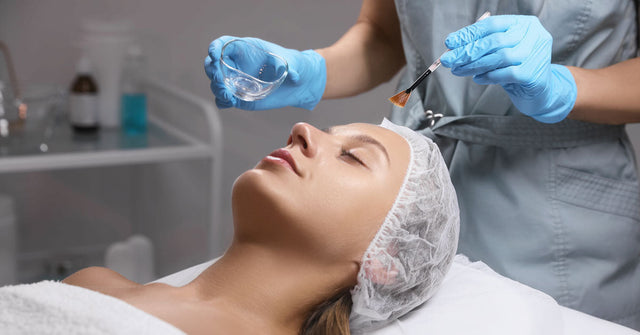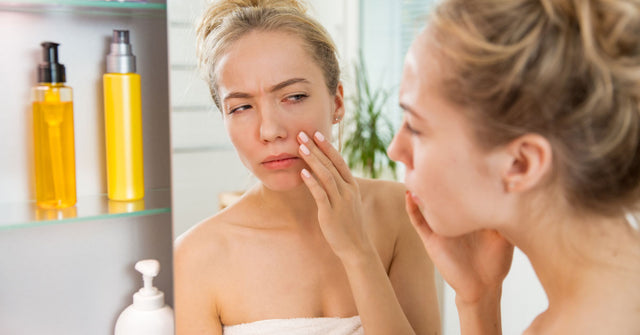Does your skin feel tight, itchy, and flaky? Dead skin on face can manifest as a rough, uneven texture and feels bumpy and grainy when touched.
Everyone wants to have smooth and supple skin but, if you allow dead skin to accumulate, it will be difficult to have a radiant complexion. While exfoliation can help, it may be a good idea to have a combination of treatments.
What Is Dead Skin?
The outer layer of the skin is composed of microscopic but tough protein cells called keratinocytes. They make up around 90% of the cells. These cells naturally shed from the skin as part of the skin's renewal process through a method known as desquamation.
According to the NIH, dead skin cells are a normal and integral part of the skin's renewal process, however, these cells are bigger than the living cells beneath them. When they accumulate, they make the skin feel dull and rough.
The skin on the face is different from the skin on the rest of the body. Facial skin is constantly exposed to the environment making it thin and more sensitive. Dead skin cells on the face tend to shed more rapidly.
How Dead Skin Cells Accumulate?
Our skin renews itself. As new skin cells begin to form in the deeper layers of the epidermis, the old cells get pushed toward the surface. These older cells gradually lose their moisture, become flat, and eventually die.
It is completely normal for the top layer of dead skin cells to slough off on their own but, as we get older, the face starts accumulating more and more dead skin cells. The natural process of desquamation begins to slow down, which is why the older you get, the more flaky, uneven, and dull the skin can become.
Why Should You Remove Dead Skin?
According to studies from Dermatologic Therapy, the skin needs proper care. Regular facial cleansing removes dead surface cells, bacteria, and dirt from the skin. Mild cleansing should be practiced regularly but, you shouldn’t overdo the skincare routine, as it can damage the stratum corneum (outer layer of the epidermis) and weaken the skin barrier. Use of a dead skin remover can prevent clogged pores and uneven texture, and help you attain softer, smoother-looking skin.
What Causes Dead Skin on the Face?
The skin has to shed every 28 days but, when there is too much dead skin left on the face, they start to affect the overall look of the skin.
Many factors can lead to dead skin on face and the main culprit is inadequate exfoliation. Here is a quick look at some of the underlying causes.
Environmental Factors:
- Dry air
- Cold weather
- Pollution
Personal Habits:
- Poor cleansing routine
- Not enough hydration
- Poor nutrition (e.g. diet high in fat, sugar, and alcohol, deficiency in essential fatty acids, vitamin D, vitamin A, iron, or zinc)
- Smoking
- Aging
- Sun damage (e.g. not applying sunscreen, or spending too much time under the heat of the sun)
- Genetics
- Hormonal changes (e.g. menstruation, imbalanced thyroid hormones, menopause, and perimenopause)
- Allergies
- Using chemically-enriched skin care products (products with harsh ingredients and chemicals can disrupt the skin’s pH balance and cause a build-up of dead skin cells)
One of the most common causes of dead skin on face is a poor cleansing routine. If you do not clean your face properly, you disrupt the natural balance of your skin’s pH level, natural oils, and beneficial bacteria.
When you don’t regularly cleanse the face, all the sweat, oil, dirt, and other impurities mix with the skin’s natural oils and make it difficult for the skin to shed its dead cells properly. This can lead to clogged pores, which in turn can trap dead skin on face.
How to Know if You Have Dead Skin?
Before we talk about how to remove dead skin from face, you must recognize the problem. Does your skin flake off whenever you scratch it? These cells form large clumps and accumulate on your face like dust.
Most of the time, the face doesn’t fully shed the dead skin cells. These mix with grime and dirt and can settle in your pores and make the skin feel rough, dull, and uneven. The longer you leave the dead skin cells, oil, and dirt stuck in the pores, the bigger your chances of acne breakouts. So, keeping the dead skin cells in check with exfoliation is a major part of having that smooth, radiant-looking skin.
Symptoms of Dead Skin on Face
Recognizing the signs of dead skin on face is the first step to addressing the problem. Based on studies from the National Library of Medicine, people with dry skin usually feel a sense of flaking, scaling, skin tightness, and roughness.
Here is a list of some of the symptoms:
- Dry, scaly skin
- Skin looks dull or tired
- Premature skin aging
- Peeling or flaky skin
- Congested pores
- Thick skin that feels rough to the touch
- Cracks in the skin
Most people experience dry skin at some point in their lives. This problem can happen because of a deficiency of lipids (natural fats) in the skin. The dryness can be a temporary or a chronic problem for both men and women. However, there is a higher prevalence of dry skin in people older than 60.
How to Remove Dead Skin From Face?
Do you want a radiant-looking skin? Here are a couple of options for you to try.
1. Exfoliation
To remove dead skin on face, you need to exfoliate by doing these:
2. Physical Exfoliation
Physical exfoliation takes a hands-on approach. You will use a sponge or gloves to slough off the dead skin cells. Just massage your face gently to reveal smoother skin.
3. Chemical Exfoliation
Chemical exfoliation is a more sophisticated process. It involves the use of chemical exfoliants such as malic acids, lactic, and glycolic acids. These products dissolve the dead skin cells and strengthen the skin’s barrier function. They tend to be less abrasive, which makes them a better option for people with sensitive skin.
4. Face Masks
A face mask can get rid of impurities, absorb excess oil, and calm the skin. They can hydrate dry skin and supply the face with ingredients that nourish the skin’s barrier.
5. Regular Cleansing
Regular cleansing removes the dirt, bacteria, and other pollutants from your face. The best way to wash the face is to use a cleanser like Dermpura but avoid excessive rubbing. Instead, splash water on your skin a couple of times and gently pat it dry. The Rejuvoderm Clarifying Cleanser can make an excellent addition to your cleansing routine. This product gently exfoliates the skin and gets rid of any oil, dirt, or bacteria that accumulate over time.
6. Apply Moisturizer
The main purpose of a moisturizer is to give your skin extra moisture and prevent it from drying out. You can upgrade your skincare routine with the Infusoderm Deep Hydration Daily Moisturizer which is packed with natural ingredients that can revitalize the skin.
7. Stay Hydrated
Hydration is vital for dry skin as it replenishes lost moisture and fortifies the skin’s natural barrier.
8. Sun Protection
With the Dermaxsol Hydrating Spf Daily Moisturizer, you can protect the skin against harmful UV rays and retain its moisture.
9. Use Gentle Skincare Products
Use gentle formulas that are packed with nourishing ingredients to avoid irritating the skin.
10. Professional Help
Consult with a dermatologist if the dead skin on face is a persistent problem.
11. Healthy Lifestyle
Consume a balanced diet with vegetables and fruits high in water.
Frequently Asked Questions
How long will dead skin stay on my face?
It is different for everyone. But, the skin’s natural turnover process usually takes about 28 days.
Why does dead skin stick to your face?
The sebaceous glands produce natural oils known as sebum. The sebum can sometimes make dead cells clump together.
How much dead skin is normal?
It is completely normal for the skin to shed around 30,000 to 40,000 cells every minute.
Conclusion
Remember, everyone has dead skin on face. With the proper care and exfoliation, you can have a radiant-looking skin. Treat your skin well, and wash it gently using the right skincare products.
References
1] https://promocell.com/cell-culture-basics/keratinocytes/
2] https://training.seer.cancer.gov/melanoma/anatomy/layers.html
3] https://forefrontdermatology.com/skin-fun-facts/
4] https://pubmed.ncbi.nlm.nih.gov/14728696/
5] https://www.ncbi.nlm.nih.gov/books/NBK565884/
6] https://www.ncbi.nlm.nih.gov/pmc/articles/PMC5172479/
Mentioned in this article
More stories

Chemical Peel for Hyperpigmentation: What You Need to Know






